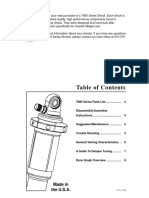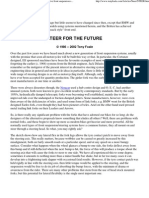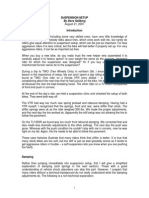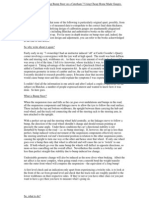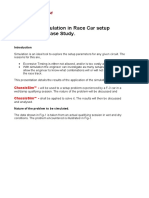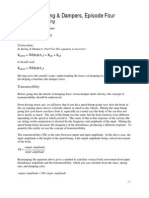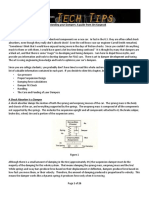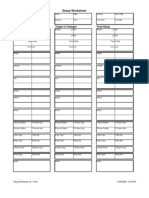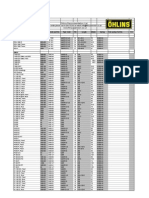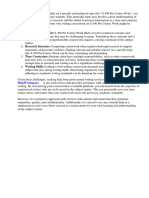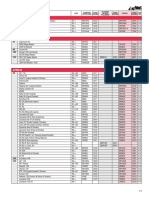0 ratings0% found this document useful (0 votes)
26 viewsMotorcycle Safety Factsheet Sep2010
Motorcycle Safety Factsheet Sep2010
Uploaded by
everlord123The document outlines new motorcycle safety initiatives in Queensland, including:
1. The Learner Approved Motorcycle Scheme (LAM), which limits learner riders to approved motorcycles under 660cc and with power-to-weight ratios below 150kW per tonne.
2. Restrictions for learner riders preventing carrying pillion passengers, to allow focus on basic riding skills without added burden.
3. A requirement for learner riders with P1 or P2 licenses to display red or green "P" plates, respectively, on the rear of their motorcycles.
Copyright:
© All Rights Reserved
Available Formats
Download as PDF, TXT or read online from Scribd
Motorcycle Safety Factsheet Sep2010
Motorcycle Safety Factsheet Sep2010
Uploaded by
everlord1230 ratings0% found this document useful (0 votes)
26 views3 pagesThe document outlines new motorcycle safety initiatives in Queensland, including:
1. The Learner Approved Motorcycle Scheme (LAM), which limits learner riders to approved motorcycles under 660cc and with power-to-weight ratios below 150kW per tonne.
2. Restrictions for learner riders preventing carrying pillion passengers, to allow focus on basic riding skills without added burden.
3. A requirement for learner riders with P1 or P2 licenses to display red or green "P" plates, respectively, on the rear of their motorcycles.
Original Description:
Motorcycle Safety Factsheet Sep2010
Copyright
© © All Rights Reserved
Available Formats
PDF, TXT or read online from Scribd
Share this document
Did you find this document useful?
Is this content inappropriate?
The document outlines new motorcycle safety initiatives in Queensland, including:
1. The Learner Approved Motorcycle Scheme (LAM), which limits learner riders to approved motorcycles under 660cc and with power-to-weight ratios below 150kW per tonne.
2. Restrictions for learner riders preventing carrying pillion passengers, to allow focus on basic riding skills without added burden.
3. A requirement for learner riders with P1 or P2 licenses to display red or green "P" plates, respectively, on the rear of their motorcycles.
Copyright:
© All Rights Reserved
Available Formats
Download as PDF, TXT or read online from Scribd
Download as pdf or txt
0 ratings0% found this document useful (0 votes)
26 views3 pagesMotorcycle Safety Factsheet Sep2010
Motorcycle Safety Factsheet Sep2010
Uploaded by
everlord123The document outlines new motorcycle safety initiatives in Queensland, including:
1. The Learner Approved Motorcycle Scheme (LAM), which limits learner riders to approved motorcycles under 660cc and with power-to-weight ratios below 150kW per tonne.
2. Restrictions for learner riders preventing carrying pillion passengers, to allow focus on basic riding skills without added burden.
3. A requirement for learner riders with P1 or P2 licenses to display red or green "P" plates, respectively, on the rear of their motorcycles.
Copyright:
© All Rights Reserved
Available Formats
Download as PDF, TXT or read online from Scribd
Download as pdf or txt
You are on page 1of 3
Motorcycle safety initiatives
Key rules for motorcycle riders:
1. Learner Approved Motorcycle Scheme
2. Pillion passenger restrictions for
learner riders
3. Requirements to display a P plate
1. Learner Approved Motorcycle Scheme
A Learner Approved Motorcycle Scheme (LAM
scheme) is now operating in Queensland. Under
the scheme, class RE licence holders are only able
to ride motorcycles that are LAM scheme approved.
Learner riders (holders of a Queensland class RE
learner licence) are also only able to ride
motorcycles that are LAM scheme approved.
Why is the type of motorcycle that a class RE
licence holder is authorised to ride changing?
A 250 ml limitation was introduced in Queensland
when a small capacity engine generally related to
the performance of the motorcycle. Due to
advancements in technology, this is no longer the
case and a number of modern 250ml motorcycles
have performance capabilities that are not suitable
for inexperienced riders. The LAM scheme will
replace the current 250ml engine capacity limit
applied to class RE licence holders.
The introduction of the LAM scheme provides
consistency between Queensland and other
Australian states.
What is a class RE motorcycle?
A class RE motorcycle is a learner approved
motorcycle, including a moped.
What is a learner approved motorcycle?
A learner approved motorcycle is a production
motorcycle that is fitted with an electric motor, or
has an internal combustion engine with an engine
capacity of not more than 660ml and:
has a power-to-weight ratio of not more than
150kW per tonne
that has not been modified other than for an
allowable modification
that is stated to be a learner approved
motorcycle in a list kept by the chief executive
and published on the departments website at
www.tmr.qld.gov.au.
What is the power-to-weight ratio of a
motorcycle?
The power-to-weight ratio is obtained by dividing
the maximum engine power by the sum of the tare
mass of the motorcycle plus 90kg and multiplying
the answer by 1,000 expressed as kilowatts per
tonne.
How is the power-to-weight ratio of a
motorcycle worked out?
The motorcycles maximum engine power in
kilowatts is divided by the prescribed weight of the
motorcycle then multiplied by 1,000 for conversion
to kilowatts per tonne. The prescribed weight of the
motorcycle means the tare mass, in kilograms, of
the motorcycle plus 90kg, that is:
Example:
The power-to-weight ratio of a motorcycle that has
a maximum engine power of 54kW and a tare mass
of 360kg is calculated by dividing 54kW by the sum
of 360kg and 90kg (that is, 450kg) and multiplying
the product of the division by 1,000. In this
example, the power-to-weight ratio is 120kW/t.
54 kW
(360 kg +90 kg)
What is a production motorcycle?
A production motorcycle is a motorcycle that is
manufactured and marketed in volume for normal
road use and conforms with the requirements that
apply to the motorcycle under vehicle law.
A production motorcycle may be modified and still
be considered a learner approved motorcycle,
provided the modification is an allowable
modification.
What is an allowable modification?
An allowable modification is a modification that is
approved under the Transport Operations (Road
Maximum Engine Power (kW) x 1000 =Kilowatts per tonne (kW/t)
Prescribed Weight (kg)
Use Management Vehicle Standards and
Safety) Regulation 2010.
The modification may either be to the seating
capacity of the motorcycle or a modification
designed to enable a person with a physical
impairment to ride the motorcycle. However,
it does not include a modification that increases the
maximum engine power of the motorcycle.
How is a learner approved motorcycle
identified?
The departments website will list those
motorcycles that are learner approved motorcycles.
Whilst most motorcycles with an engine capacity of
less than 250ml will be considered a learner
approved motorcycle, those that have a power-to-
weight ratio of more than 150kW per tonne are
excluded. There will be an additional list that will
help identify those motorcycles that are not a
learner approved motorcycle.
The vehicle registration label will help identify the
motorcycle as being a learner approved motorcycle
with the exception of a production motorcycle that
is conditionally registered.
Which motorcycles are prescribed
motorcycles?
The following six models of motorcycles, although
250ml or under, have been identified as a
prescribed motorcycle, and are not learner
approved motorcycle:
Aprilia RS250
Honda NSR250
Kawasaki KR250 (KR-1 model)
Kawasaki KR250 (KR1s model)
Suzuki RGV250
Yamaha TZR250.
Why have these prescribed motorcycles been
excluded from the learner approved motorcycle
list?
These motorcycles are capable of high speed and
rapid acceleration. They are regarded as being
unsuitable for inexperienced riders due to their
sports style power delivery, handling and riding
position
What class of licence will I need to ride a
prescribed motorcycle?
You will need a class R licence to ride a prescribed
motorcycle.
What class of licence do I need to ride a
conditionally registered motorcycle that is not a
production motorcycle?
You need a class R licence to ride a conditionally
registered motorcycle that is not a production
motorcycle.
Are there any changes to the types of
motorcycles I can ride under a class R licence?
No. You can still ride a motorcycle of any engine
capacity including a learner approved motorcycle
and a moped.
When can I learn to ride a class R motorcycle?
You may learn to ride a class R motorcycle after
you have held a class RE motorcycle licence
(excluding a learner licence) for at least one year.
When can I learn to ride a class R motorcycle?
You may learn to ride a class R motorcycle after
you have held a class RE motorcycle licence
(excluding a learner licence) for at least one year.
What will happen if I am found riding a class R
motorcycle unaccompanied and I only hold a
class RE licence?
You may receive an infringement notice or be
required to appear in a court for unlicensed driving.
If you are convicted of unlicensed driving the court
may impose a fine of up to $4,400.
Is a moped a learner approved motorcycle?
Yes.
2. Pillion passenger restrictions for
learner riders
Am I able to carry a supervisor as a pillion
passenger on my motorcycle when learning to
ride?
No. You are not able to carry a supervisor as a
pillion passenger on your motorcycle while you are
learning to ride the motorcycle.
How can I learn to ride a motorcycle if I can not
carry my supervisor as a pillion passenger?
As a learner you are still required to be supervised
by an appropriately licensed person when riding a
motorcycle. You may only carry a supervisor
seated in a sidecar attached to the motorcycle. If
the motorcycle does not have a sidecar, the
supervisor may follow you at a safe distance on
another motorcycle or in another motor vehicle.
When will I be able to carry a passenger as a
pillion on my motorcycle?
You are only allowed to carry a passenger on a
motorcycle if you hold a provisional or open licence
that authorises you to ride that class of vehicle and
you have held that class of licence for at least one
year.
A passenger on a motorcycle includes a pillion
passenger and a person seated in a sidecar
attached to the motorcycle.
However, while learning to ride you may carry a
supervisor seated in a sidecar attached to the
motorcycle.
Why has this new passenger restriction for
learner riders been introduced?
Evidence suggests carrying passengers increases
the risk to the rider and the passenger and can lead
to more severe injuries in the event of a crash.
Carrying a pillion passenger requires more
advanced riding skills to accommodate the
passengers impact on the balance and stability of
the motorcycle. This new restriction will remove the
added burden on learner riders to allow them to
concentrate on developing basic on-road riding
skills.
3. Requirement to display a P plate
Am I required to display a 'P' plate on a
motorcycle?
Yes, you are required to display a P plate on a
motorcycle if you hold a class RE or R motorcycle
P1 or P2 type licence.
The requirement to display a P plate on a
motorcycle (including mopeds) will continue until
you upgrade to an open type licence.
If you are the holder of an open driver licence and
obtain an RE or R class motorcycle licence, you will
not be required to display a P plate.
What colour 'P' plate will I be required to display
when riding my motorcycle?
Similar to the requirements to displaying 'P' plates
on cars, P1 licence holders will be required to
display a red P plate and P2 licence holders must
display a green P plate on the rear of the
motorcycle, or on the back of a vest worn by the
rider.
Will I need to display a 'P' plate on the front and
rear of my motorcycle?
No. Similar to the current requirements for display
of an 'L' plate on a motorcycle, you will only need to
display a 'P' plate on the rear of the motorcycle.
Where can I find more information?
For a full list of learner approved motorcycles,
information regarding the Learner Approved
Motorcycle Scheme, how to apply for a class RE or
R licence, and other motorcycle rules visit
www.motorcyclesafety.qld.gov.au or call 13 23 80.
You might also like
- Tabla de Holgura de Válvulas de MotosDocument1 pageTabla de Holgura de Válvulas de Motosedisson sanabria89% (35)
- OvalCrewChief101 v5Document7 pagesOvalCrewChief101 v5darakof258No ratings yet
- Vehicle Dynamics and Damping: First Revised EditionFrom EverandVehicle Dynamics and Damping: First Revised EditionRating: 4 out of 5 stars4/5 (2)
- Penske 7800 Technical ManualDocument12 pagesPenske 7800 Technical ManualgeorgeNo ratings yet
- Tech Tip: Springs & Dampers, Part One: The Phantom KnowledgeDocument21 pagesTech Tip: Springs & Dampers, Part One: The Phantom KnowledgeHenrique CarstenNo ratings yet
- Motorcycle Chassis Design and Dynamics PDFDocument3 pagesMotorcycle Chassis Design and Dynamics PDFPrasetyo Adi40% (5)
- Four-Bar Steering MechanismDocument4 pagesFour-Bar Steering MechanismmanikandanmfgNo ratings yet
- 05paintcodes PDFDocument5 pages05paintcodes PDFอัตตา ไม่มาหาNo ratings yet
- Song of The Sausage Creature by Hunter S. ThompsonDocument4 pagesSong of The Sausage Creature by Hunter S. ThompsonbutterfliesabuckeachNo ratings yet
- Motorcycle Safety Presentation 2Document29 pagesMotorcycle Safety Presentation 2vhlactaotaoNo ratings yet
- Tech110 PDFDocument4 pagesTech110 PDFPrasetyo AdiNo ratings yet
- Suspension - Spring Preload&Race SagDocument4 pagesSuspension - Spring Preload&Race Sagmakazica100% (2)
- Racing Motorcycle Dynamic Analysis ModelsDocument84 pagesRacing Motorcycle Dynamic Analysis Modelsaps uNo ratings yet
- Motorcycle Aerodynamics - Canada Moto GuideDocument17 pagesMotorcycle Aerodynamics - Canada Moto GuideangelthingNo ratings yet
- Motorcycle Steering ControlbyDocument9 pagesMotorcycle Steering Controlbyjoeni-42No ratings yet
- Camber ThrustDocument3 pagesCamber ThrustKunal SuryavanshiNo ratings yet
- Know About Motorcycle RidingDocument1 pageKnow About Motorcycle RidingDerek BoillatNo ratings yet
- Shock Speed ArticleDocument10 pagesShock Speed ArticleKathryn Workman100% (1)
- Where The Graphs Come FromDocument7 pagesWhere The Graphs Come FromRajaSekarsajjaNo ratings yet
- Application of Magic Formula Tire Model To Motorcycle Maneuverability AnalysisDocument6 pagesApplication of Magic Formula Tire Model To Motorcycle Maneuverability AnalysisliezardNo ratings yet
- CHP Motorcycle Mechanic Job BulletinDocument2 pagesCHP Motorcycle Mechanic Job BulletinDavidScardinoNo ratings yet
- Motorcycle Connecting RodsDocument1 pageMotorcycle Connecting Rodscrower_scribdNo ratings yet
- Motorcycle Safety and The Repeal of Universal Helmet LawsDocument7 pagesMotorcycle Safety and The Repeal of Universal Helmet LawsseymourwardNo ratings yet
- Determination of Anti Pitch Geometry L (/) - Acceleration (1/3)Document39 pagesDetermination of Anti Pitch Geometry L (/) - Acceleration (1/3)gashaw251No ratings yet
- Motorcycle Cornering Behavior Modeling - PaperDocument14 pagesMotorcycle Cornering Behavior Modeling - PaperRafael DonadioNo ratings yet
- Guide To Dyno GraphsDocument10 pagesGuide To Dyno GraphsRajaSekarsajjaNo ratings yet
- 2013 s1000rr Riders Manual 3rd EditionDocument181 pages2013 s1000rr Riders Manual 3rd Editiongabao123No ratings yet
- The Five Most Common Motorcycle Accidents:: How To Avoid ThemDocument16 pagesThe Five Most Common Motorcycle Accidents:: How To Avoid ThemfaufuNo ratings yet
- Tony Foale Designs - Vyrus Suspension HistoryDocument7 pagesTony Foale Designs - Vyrus Suspension HistoryStuart CouttsNo ratings yet
- Race Car Weight Transfer and Handling Examples For Suspension Set UpDocument3 pagesRace Car Weight Transfer and Handling Examples For Suspension Set Upmav87th-1No ratings yet
- Setup by Location PDFDocument1 pageSetup by Location PDFBuddy FeyNo ratings yet
- Suspension Set Up Explained: The Components, Where Are They and What Do They DoDocument5 pagesSuspension Set Up Explained: The Components, Where Are They and What Do They Doaf00712210No ratings yet
- Lean Angle MotorcycleDocument10 pagesLean Angle MotorcycleGabriel NunesNo ratings yet
- Paul Frère's Dos and Don'ts of Sports Car and Competition DrivingDocument6 pagesPaul Frère's Dos and Don'ts of Sports Car and Competition DrivingBentley PublishersNo ratings yet
- Suspension Setup PDFDocument11 pagesSuspension Setup PDFPrasetyo AdiNo ratings yet
- 2021.12.08 Ligier Js PX BrochureDocument14 pages2021.12.08 Ligier Js PX BrochureMarco Beretta100% (1)
- Measuring and Correcting Bump Steer On A Caterham 7Document8 pagesMeasuring and Correcting Bump Steer On A Caterham 7damdy-cashNo ratings yet
- Brake Tech Tip PDFDocument4 pagesBrake Tech Tip PDFvijayakkannanNo ratings yet
- ChassisSim F3 Case StudyDocument6 pagesChassisSim F3 Case Studytushar girotraNo ratings yet
- A Quick Guide To Motorcycle RakeDocument11 pagesA Quick Guide To Motorcycle Rakesatria hiuNo ratings yet
- FSAE Data Analysis Day 2 To PrintDocument55 pagesFSAE Data Analysis Day 2 To PrintJorge CorderoNo ratings yet
- Chassis OptimizationDocument42 pagesChassis OptimizationNavyadeep SaiNo ratings yet
- OptimunG Springs&Dampers Tech Tip 4Document5 pagesOptimunG Springs&Dampers Tech Tip 4Thomas Moura100% (1)
- CG Measurement of MotorcycleDocument9 pagesCG Measurement of MotorcyclePrasanna MahendiranNo ratings yet
- Grand Prix Motorcycle RacingDocument3 pagesGrand Prix Motorcycle RacingKavilan MaganNo ratings yet
- J-Dampers in Formula OneDocument3 pagesJ-Dampers in Formula Onertech01No ratings yet
- MotorcycleHelmet ImpactResponse IRCOBI 15 91Document11 pagesMotorcycleHelmet ImpactResponse IRCOBI 15 91deny ponimanNo ratings yet
- Puma Race Engines - Cylinder Head Modifications - Part 1: Valve SeatsDocument4 pagesPuma Race Engines - Cylinder Head Modifications - Part 1: Valve SeatsRobert DennisNo ratings yet
- Dynojet Research Motorcycle Accessories 250Document31 pagesDynojet Research Motorcycle Accessories 250cesarNo ratings yet
- Race Car Gear BoxDocument5 pagesRace Car Gear Boxmuhammad zia ur rehmanNo ratings yet
- Skippy Tuning Guide 2011 S1Document26 pagesSkippy Tuning Guide 2011 S1dust1977No ratings yet
- Motorcycle Handbook enDocument19 pagesMotorcycle Handbook enMike UyNo ratings yet
- Grand Prix Motorradmotoren Design Alternatives For MotoGP Engines Gordon P. BlairDocument14 pagesGrand Prix Motorradmotoren Design Alternatives For MotoGP Engines Gordon P. BlairLuizGustavoVicenteNo ratings yet
- A Guide To Your Dampers Chapter From FSAE Book by Jim Kasprzak UpdatedDocument26 pagesA Guide To Your Dampers Chapter From FSAE Book by Jim Kasprzak UpdatedPRAVEEN KUMARNo ratings yet
- Thesis Remco Advocaat 1275674Document131 pagesThesis Remco Advocaat 1275674Angel BorsaniNo ratings yet
- Motorcycle HandbookDocument56 pagesMotorcycle HandbookKimberly Rivera100% (2)
- OptimunG Springs&Dampers Tech Tip 2Document3 pagesOptimunG Springs&Dampers Tech Tip 2Thomas MouraNo ratings yet
- Setup Worksheet Blank PDFDocument2 pagesSetup Worksheet Blank PDFBuddy Fey100% (1)
- PD - Alumni & Marketing CoordinatorDocument4 pagesPD - Alumni & Marketing Coordinatoreverlord123No ratings yet
- Court of Petty Sessions Ordinance (No. 2) 1930Document2 pagesCourt of Petty Sessions Ordinance (No. 2) 1930everlord123No ratings yet
- PD Lecturer in BioprocessingDocument5 pagesPD Lecturer in Bioprocessingeverlord123No ratings yet
- Crimes (Transitional Provisions) Regulation 2009 (Repealed) : Australian Capital TerritoryDocument9 pagesCrimes (Transitional Provisions) Regulation 2009 (Repealed) : Australian Capital Territoryeverlord123No ratings yet
- PD Lecturer-Senior LecturerDocument5 pagesPD Lecturer-Senior Lecturereverlord123No ratings yet
- Crimes (Transitional Provisions) Regulation 2009: Australian Capital TerritoryDocument8 pagesCrimes (Transitional Provisions) Regulation 2009: Australian Capital Territoryeverlord123No ratings yet
- Flammable Nightwear Ordinance 1975Document1 pageFlammable Nightwear Ordinance 1975everlord123No ratings yet
- Credit Regulation 1985 (Repealed) : Australian Capital TerritoryDocument43 pagesCredit Regulation 1985 (Repealed) : Australian Capital Territoryeverlord123No ratings yet
- Children and Young People Regulation 2000: Australian Capital TerritoryDocument9 pagesChildren and Young People Regulation 2000: Australian Capital Territoryeverlord123No ratings yet
- Magistrates Court (Civil Jurisdiction) (Solicitors' Costs) Regulation 1982Document32 pagesMagistrates Court (Civil Jurisdiction) (Solicitors' Costs) Regulation 1982everlord123No ratings yet
- Court of Petty Sessions (Civil Jurisdiction) (Solicitors' Costs) RegulationsDocument7 pagesCourt of Petty Sessions (Civil Jurisdiction) (Solicitors' Costs) Regulationseverlord123No ratings yet
- Children and Young People Regulations 2000: Australian Capital TerritoryDocument4 pagesChildren and Young People Regulations 2000: Australian Capital Territoryeverlord123No ratings yet
- Magistrates Court (Civil Jurisdiction) (Solicitors' Costs) Regulation 1982 (Repealed)Document32 pagesMagistrates Court (Civil Jurisdiction) (Solicitors' Costs) Regulation 1982 (Repealed)everlord123No ratings yet
- Hospitals ActDocument9 pagesHospitals Acteverlord123No ratings yet
- Children's Services Regulations: Australian Capital TerritoryDocument6 pagesChildren's Services Regulations: Australian Capital Territoryeverlord123No ratings yet
- Consumer Credit Regulation 1996: Australian Capital TerritoryDocument10 pagesConsumer Credit Regulation 1996: Australian Capital Territoryeverlord123No ratings yet
- Consumer Credit Regulations: Australian Capital TerritoryDocument3 pagesConsumer Credit Regulations: Australian Capital Territoryeverlord123No ratings yet
- Regulations Under The Careless Use of Fire Ordinance 1936-1937Document1 pageRegulations Under The Careless Use of Fire Ordinance 1936-1937everlord123No ratings yet
- Consumer Credit Regulation 1996 (Repealed) : Australian Capital TerritoryDocument10 pagesConsumer Credit Regulation 1996 (Repealed) : Australian Capital Territoryeverlord123No ratings yet
- Canberra Theatre Trust OrdinanceDocument2 pagesCanberra Theatre Trust Ordinanceeverlord123No ratings yet
- The Territory For The Seat of Government.: By-Laws Under The Canberra Community Hospital Board Ordinances 1935Document11 pagesThe Territory For The Seat of Government.: By-Laws Under The Canberra Community Hospital Board Ordinances 1935everlord123No ratings yet
- PD Manager Human DevelopmentDocument3 pagesPD Manager Human Developmenteverlord123No ratings yet
- Regulations 1975 No. 27: Authority Ordinance 1974.Document2 pagesRegulations 1975 No. 27: Authority Ordinance 1974.everlord123No ratings yet
- Schedule of Meifu-Shinakge Ryu: Schedule of Regular Shuriken Class Schedule of Various EventsDocument1 pageSchedule of Meifu-Shinakge Ryu: Schedule of Regular Shuriken Class Schedule of Various Eventseverlord123No ratings yet
- Road Rules Act GovernmentDocument374 pagesRoad Rules Act Governmenteverlord123No ratings yet
- Benelli (Motorcycles) - WikipediaDocument26 pagesBenelli (Motorcycles) - WikipediaDeepak Jo BenelliluvrNo ratings yet
- Ohlins Recommendation ListDocument8 pagesOhlins Recommendation ListnicktieNo ratings yet
- ROLON Other Than Kit MRP Wef. Mar'21Document11 pagesROLON Other Than Kit MRP Wef. Mar'21Shailendra SharmaNo ratings yet
- VIJJU ImpDocument34 pagesVIJJU ImpPrem RajNo ratings yet
- Design Considerations or Factors of A Two Wheeler SuspensionDocument44 pagesDesign Considerations or Factors of A Two Wheeler SuspensionViswaChaitanya Nandigam100% (2)
- 2016 Supersport: WWW - Yamaha-Motor - Eu/ukDocument17 pages2016 Supersport: WWW - Yamaha-Motor - Eu/ukRohit ChatterjeeNo ratings yet
- S-390 Pre Course WorkDocument6 pagesS-390 Pre Course Workbotav1nakak3100% (2)
- Motoroids2 February 2010Document69 pagesMotoroids2 February 2010Amit ChhanganiNo ratings yet
- Full 1Document1 pageFull 1Rubén Sánchez PayerasNo ratings yet
- 5 Most Expensive Bikes in The WorldDocument1 page5 Most Expensive Bikes in The WorldsadeepNo ratings yet
- Pirelli 2020 LRDocument92 pagesPirelli 2020 LRAntonio Marco SorianoNo ratings yet
- Nok Two Wheeler MRP List Wef 1.4.2021Document4 pagesNok Two Wheeler MRP List Wef 1.4.2021Senthil KumarNo ratings yet
- Next Generation Daytona Moto2™ 765 For The RideDocument1 pageNext Generation Daytona Moto2™ 765 For The RideEduardo Rafael BenjamimNo ratings yet
- 24 Heures Motos - 24 Heures Motos - Hour by Hour Classifications - Race Leader After 21 HoursDocument3 pages24 Heures Motos - 24 Heures Motos - Hour by Hour Classifications - Race Leader After 21 HoursKévin GintratNo ratings yet
- PlistDocument73 pagesPlistRaxit PaRmar100% (1)
- On Any Sunday Rider Ebook PJO13734Document446 pagesOn Any Sunday Rider Ebook PJO13734Jedd Arapoc Pagente RocasNo ratings yet
- Ducati Valve Shim Application Chart060810Document1 pageDucati Valve Shim Application Chart060810Jason CreeNo ratings yet
- Two Wheeler Auction 28thaprilDocument64 pagesTwo Wheeler Auction 28thaprilAnonymous rtDlncdNo ratings yet
- MA SAT Barnett PDFDocument72 pagesMA SAT Barnett PDFtran tedaoNo ratings yet
- F Keterampilan Bahasa Inggris XI MIPA 6 (Ok)Document48 pagesF Keterampilan Bahasa Inggris XI MIPA 6 (Ok)linaNo ratings yet
- BENELLIDocument6 pagesBENELLIGabriel ChiavettoNo ratings yet
- Open & Close Loop Control SystemDocument6 pagesOpen & Close Loop Control SystemIlham AkbarNo ratings yet
- DISC BRAKE PAD DID 1.12.2024Document4 pagesDISC BRAKE PAD DID 1.12.2024alc2673No ratings yet
- NGK Moto Catalog 13-69Document57 pagesNGK Moto Catalog 13-69Sunny SoniNo ratings yet
- Motorcycle Components - Wikipedia PDFDocument35 pagesMotorcycle Components - Wikipedia PDFJunior EdgerNo ratings yet
- 2022 10 13AustralianMotorcycleNewsDocument117 pages2022 10 13AustralianMotorcycleNewscivalNo ratings yet
- Harley-Davidson X440 Vs Royal Enfield Hunter 350 Vs Triumph Speed 400 - Know WhiDocument10 pagesHarley-Davidson X440 Vs Royal Enfield Hunter 350 Vs Triumph Speed 400 - Know WhiPardeep YadavNo ratings yet



